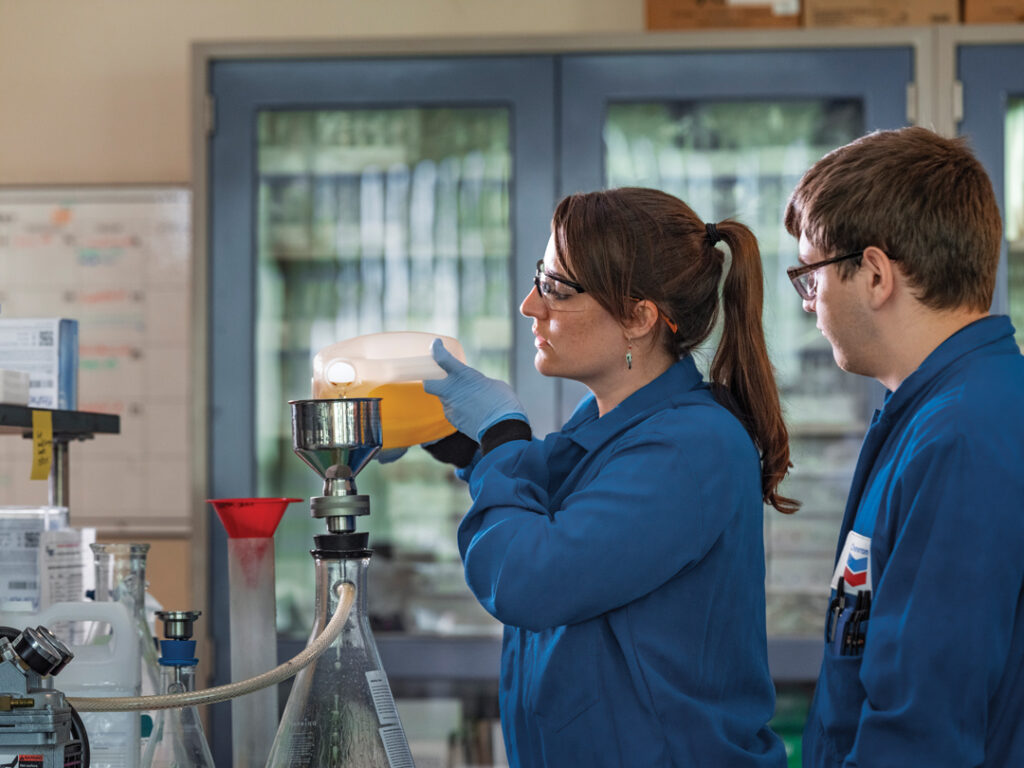Some TLC for Iowa’s teachers
What will the Teacher Leadership and Compensation program mean for Iowa’s school districts?

Iowa teachers and school districts are transitioning to a new leadership mentoring model aimed at developing better teacher-leaders and creating opportunities for teachers to coach their peers in better classroom instruction techniques.
The Teacher Leadership and Compensation (TLC) System is built on the premise that rewarding effective teachers with leadership opportunities and higher pay will result in better teachers — and thus better learning results — overall.
For school districts, the program is a culture-shifting experiment in which many of the best classroom teachers will be paid more to mentor other teachers full time rather than teach in the classroom.
Some districts are also creating in-classroom mentorship opportunities in which teachers can observe selected teachers to model their teaching techniques.
Seeking better results
A year ago, 39 initial school districts began implementing the program as part of a three-year process to have all districts in the state voluntarily participate. The program’s funding, paid initially through three annual legislative appropriations of $50 million, will become part of each district’s permanent funding formula. However, it is “categorical” funding, meaning it must be used specifically for the training and mentoring program.
“TLC really aligns professional development of teachers with this system, which means teachers have the opportunity to actually lead their own professional learning,” said Ryan Wise, director of the Iowa Department of Education. “If you give teachers the opportunity and position them to lead the learning for other teachers, you’re going to get better results.”
The program, which was enacted by the Iowa Legislature in 2013, also requires participating districts to increase the starting salary of teachers to a minimum $33,500 per year, a level that most larger districts, such as those in Greater Des Moines, already surpass.
Wise, a former teacher who was appointed July 1 by Gov. Terry Branstad to lead the department, said the program takes a comprehensive approach to teacher leadership development. He helped lead the development of the program while he was the department’s deputy director.
“I think TLC is so exciting because it combines all of these things into one effort,” he said “It combines raising salaries and improving entry on the front end with opportunities for growth throughout the career, with the day-to-day professional learning a teacher gets. Those things come together to really make TLC the most comprehensive and innovative teacher leadership program in the country. So that’s really exciting.”
Funding remains a concern
Some teachers, parents and administrators have raised concerns that the program will take many of the best teachers out of day-to-day classroom teaching so that they can devote their full day to mentoring other teachers. State education leaders say that trade-off is worth the effort to produce more great teachers overall.
With the contentious school funding debate earlier this year at the Statehouse followed by Gov. Branstad’s veto of $55.7 million of additional education funding, there is also concern within the districts that TLC will be undermined by a failure of the Legislature to continue funding basic education programs at a sustainable level.
“There have been some pilot projects of this type in the past that have gone away,” said Mary Jane Cobb, executive director of the Iowa State Education Association. “In the early days (of the TLC program), before people really understood the funding mechanism, there were more concerns.
“School funding feels pretty tenuous to all of us right now,” said Cobb, whose organization represents more than 34,000 teachers, educational specialists and support staff statewide. “I don’t know that anybody feels incredibly confident it’s always going to be there. I think the greater risk for us is the idea we could be funding a teacher leadership system that does have the potential to be transformative, but not funding our regular program that it’s supporting. That creates some skepticism and concern.”
As an example, in one district that had received TLC funding, a music teacher had accepted a TLC position, but because of funding limitations, the district cut the music program, Cobb said. “This poor teacher feels like she shouldn’t have applied for that TLC position, and maybe they would still have the music program. … It puts a little bit of a strain on the implementation of the teacher-leadership system.”
Another significant concern to overcome about the program was the idea of removing excellent teachers from classroom teaching.
“So helping people understand that having this creative, talented teacher work with a number of colleagues on strategies to improve everybody’s practice really does benefit all the students and teachers,” Cobb said. “It’s just a shift in mindset that I think was challenging not only for teachers but also for parents. If you thought your child was going to have a particular third-grade teacher and now they’re a teacher-leader, there may be some angst about that.”
Keeping new teachers
The TLC program recently was hailed by U.S. Education Secretary Arne Duncan, who sat in on a teacher coaching session when his annual back-to-school bus tour made stops in Iowa.
“You are literally at the forefront” in teacher leadership, Duncan told panelists at a forum at Roosevelt Middle School in Cedar Rapids, The Gazette reported. “There’s no state providing this kind of leadership at this point.”
Victoria Robinson, interim dean of the College of Education at the University of Northern Iowa, said the innovative program provides several important benefits for Iowa college students pursuing teaching careers.
“Traditionally in education, teachers were teachers, and maybe they would make a decision to become principals and leave the classroom,” said Robinson, who served on the state’s Commission on Educator Leadership and Compensation that guided development of the program. “There really was not an additional career step for them. This gives them the ability to remain in the classroom, but also branch out and impact their colleagues.”
Additionally, Robinson hopes the program encourages new teachers to stay with the profession, particularly during the critical initial years. But most important, the program should also result in better student learning, she said.
Although there’s no definitive research that shows the program will improve student learning and there are many variables that can affect outcomes, common sense says that providing more attention to teacher leadership will make a difference, Robinson said.
“Listening to teachers, it really has energized teachers, and given teachers an opportunity to learn from each other,” she said.
$11 million increase for Des Moines
Enacted as part of an education reform bill championed by Gov. Branstad, the program provided a total of $3.5 million in training grants for all of the state’s 346 school districts, followed by three annual appropriations of $50 million to phase in all of the districts, about one-third of the state’s students in each round.
The additional funding that flows to each participating district amounts to approximately $309 per student, which for the Des Moines Public Schools, for instance, equates to an approximate $11 million increase in its $500 million budget.
That added funding has enabled the Des Moines district to hire roughly 90 additional teachers and realign positions so that 75 teachers now coach other teachers as their full-time job. In total, more than 600 Des Moines teachers — close to the program’s target of 25 percent — will be involved in TLC this school year after about 25 final positions are filled, said Anne Sullivan, the district’s chief human resources director.
“In the past, teachers have tried to serve as a mentor on the side, during their planning period or when they had time,” she said. “Now, this allows teachers serving in that teacher/mentor capacity to do it full time. And they are assigned only to teachers who have pretty much self-identified they want assistance. It really puts them not only in a leadership position, but allows them to focus their efforts that whole time.”
Des Moines Public Schools had applied for the first round of funding for the 2014-15 school year but was not among the first 39 districts selected. After hiring a consultant to refine its application and conducting parent and teacher surveys to gather more input, the district was awarded TLC funding in the second round with 75 other districts.
Wilma Gajdel, director of federal and grant programs for the district, said she’s excited about compensating teachers more fairly for the work they’re doing.
“I was a school principal and I showed up at 6:30 in the morning, and there were already teachers there for school that started at 8:15,” she said. “Teachers are hard-working people, and this is an opportunity to really pay leaders something for what they’re doing. The other big piece of it is really the cultural shift in terms of instruction and impacting kids.”
The Des Moines district has tailored the program to have several layers of teacher leadership, said Noelle Tichy, executive director of teaching and learning.
“In addition to the full-release positions — our instructional coaches — we also have positions that we call demonstration teachers who remain in the classroom, but they receive a stipend for other teachers to visit their classrooms,” Tichy said. “They still have the full load and responsibilities of a teacher, but they have the additional responsibility of welcoming other teachers into their room and modeling methods for them.”
Additionally, there are now innovation teachers who are paid extra to continue what they’ve been doing with active research projects in the classroom, she said. “They’re doing something outside of the box that we haven’t internalized as part of the system, so they can share these practices and consider, should we be looking at these practices in scale,” she said.
Not one-size-fits-all
The ISEA’s Cobb said the majority of districts so far have opted for a “create your own model” option that was one of three choices offered to the districts.
“I think that was the clearest message in the whole process, that one size would absolutely not fit every district,” Cobb said. “We wanted a system where districts could look at what their needs were and then figure out how teacher-leadership roles could help address those needs for students.”
Feedback from many of the initial 39 districts that have launched TLC has been positive, she said.
“What we’re hearing anecdotally is that it’s really going well,” she said. “There are some hiccups — it’s an implementation of a new system — but teachers are appreciative of the time to collaborate with a colleague on perhaps a problem of practice in their classroom or time to have someone come in and observe their teaching and give them some feedback.”
Cobb said there initially were concerns that teachers would not be receptive to feedback, but that doesn’t seem to be the case.
“In many districts, the coaches can’t get to all the classrooms they have requests from,” she said. “One of the reasons I think that’s happening is the collaborative nature of the process from the beginning. The planning grants and the application processes themselves really encouraged the districts to bring a broad group of stakeholders together for the planning, and the more people know about what you’re trying to accomplish, the better things go.”
Because each district is setting its own goals for the program, evaluating the success of the program will require a district-level measurement, Cobb said. The Iowa Department of Education is working on a comprehensive model to measure the results.
“I think people want one data point to tell whether this is going to work,” she said. “I think that it’s going to be a variety of data points, based on what they were trying to accomplish. Really, it’s going to be a district-by-district measure.”
From Wise’s perspective, the buy-in for TLC among the districts so far has been “tremendous,” he said.
“I think the first 39 have been incredibly enthusiastic,” he said. “I’ve personally visited about a third of the districts over the past year when I was in my deputy role. It’s just exciting to hear teachers talk about the opportunities they’ve been given to lead, and to hear administrators talk about the additional capacity that’s been built in their districts because of TLC.
“It’s also really fun to hear from brand-new teachers who have not only a mentor but a coach,” he said. “Now they feel like they’ve got three or four sources of support in their first year, where in the past maybe they had one.”
TLC Goals:
Attract promising candidates to the teaching profession by offering competitive starting salaries and offering short- and long-term professional development and leadership opportunities.
Retain effective teachers by providing enhanced career opportunities.
Promote collaboration by developing and supporting opportunities for teachers in schools and school districts statewide to learn from each other.
Reward professional growth and effective teaching by providing pathways for career opportunities that come with increased leadership responsibilities and involve increased compensation.
Improve student achievement by strengthening instruction.
Greater Des Moines school districts participating
Beginning 2014-15 school year
Johnston, North Polk, Norwalk, Saydel, Southeast Polk, West Des Moines
Beginning 2015-16 school year
Ankeny, Carlisle, Dallas Center-Grimes, Des Moines, Indianola, Urbandale, Waukee










